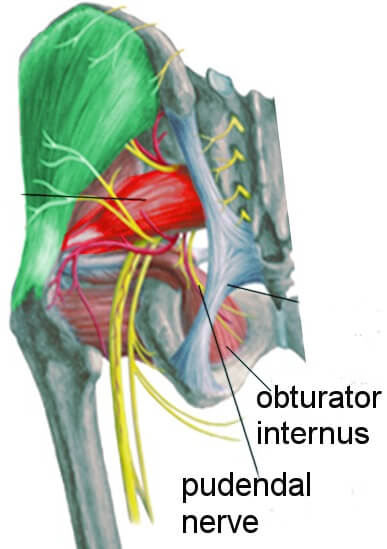Not Sciatica Yet a Real Pain in the Butt – Pelvic Floor Therapy
We should all be mindful that the pelvic floor muscles work just like any other muscles – they contract and relax and can become tight or weaken. The pelvis is our center of gravity and its position affects the position of our head, neck, shoulders and lower extremities. Pelvic floor muscle trigger points can develop over time, leading to a “pain in your butt.”
You may have experienced sciatica in the past- pain that is either in the butt that may also travel down the back of the leg. Often it is caused by irritation or compression to the sciatic nerve in the buttock, sometimes caused by the piriformis muscle. It is one of the deep hip rotators that make up the “walls” of the pelvic floor. Tightness of those muscles can cause localized pain in the pelvis, as well referred pain to the vagina or perineum. Inside of the pelvis, there is also the Pudendal nerve that is formed by the nerves of the sacral region. It provides sensation and strength to the pelvic floor muscles and we will further explore that.

It’s true – your pelvic floor muscles are directly attached to your hip muscles and that pain in the butt that’s not sciatica might originate from the Obturator Internus muscle or “OI”. The OI is a hip muscle that originates deep within the pelvis and like the piriformis muscle is one of the rotators of your hip assisting in stabilizing your pelvis. This provides stability while moving as well as being a site of attachment for the pelvic floor muscles.
Well in addition to the OI’s role in stability of movement, the OI muscle is a passageway for the pudendal nerve and blood vessels as it weaves its way through the pelvis. If the OI muscle becomes strained, tight, or weak you may experience pain near the sitting bone which you may have experienced as that pain in your butt after sitting for a while.
It just so happens that the pudendal nerve and the OI muscle occupy the same region in the pelvis. In fact there’s a point where the pudendal nerve branches off in route to 3 directions as it leaves the pelvic cavity on way to: 1) innervate the rectum; 2) reach the vaginal/perineal region and the genitals, and 3) pass through the region of the OI muscle and fascia.
Changes in hip mechanics, soft tissue, strength or coordination may contribute to pelvic symptoms if this affects the route of the pudendal nerve through the obturator muscle and fascia. Should the pudendal nerve become compressed, irritated or stretched you may feel different sensations in the pelvis such as burning, numbness, pain, irritation or itching in the rectum, vaginal regions, and/ or in the clitorial region.
Restoring mobility and function of the OI muscle, pelvic floor, and other hip muscles through the help of a pelvic floor physical therapist can help to resolve your “pain in the butt” and get you back to your active lifestyle, sex, and hobbies set aside due to pain.
Reach me if I can answer any questions on physical therapy, serving you locally in New York City or anywhere online virtually through “telehealth“.
Sign up for Pelvic Health and Wellness Tips






